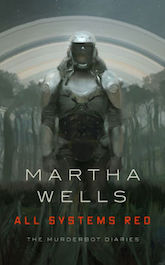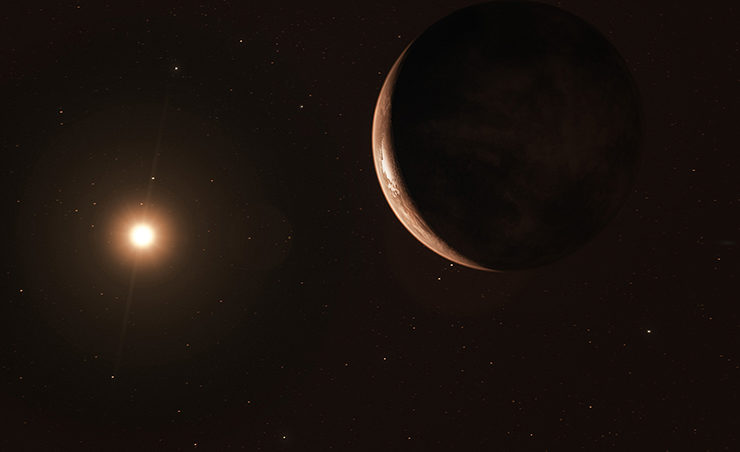What’s better: speculation and rumour, or cold fact? The protagonist of George R. R. Martin’s Hugo- and Nebula-nominated “With Morning Comes Mistfall” likes speculation and rumour, preferring a world where the existence of wraiths is debatable to one where the question has been answered. I fall firmly in the second camp (cold fact), which is why recent news from Barnard’s Star pleased me so much.
Barnard’s Star is notable in several ways. It’s considerably older than our star system, being perhaps twice as old as the Sun. It is comparatively depleted in elements heavier than hydrogen and helium (or rather, our Sun, having been formed in an era when heavy elements were more abundant, is enriched). Barnard’s Star is about one-seventh the mass of the Sun and as a consequence, it is so dim that humans did not discover it until photographic astronomy was invented, at which point E. E. Barnard noticed a curious fact about Barnard’s Star: it’s traversing our sky at an impressive rate, roughly half the angular diameter of the Moon every century.
This great rate is partly due to the fact that Barnard’s Star is scooting along at 140 km/s relative to us… but it is chiefly due to proximity. Barnard’s Star is only six light years away, which makes it the second closest stellar system to our own (Alpha Centauri is closest).
Unsurprisingly, its proximity has made it of great interest to astronomers and their ilk. Persons of a certain age might remember the British Interplanetary Society’s Project Daedalus, which proposed a fusion-propelled robot probe that at peak velocity would travel at 12% of the speed of light. That would be fast enough to get from the Earth to the Moon in just eleven seconds. It would be fast enough to traverse the distance between the Sun and Barnard’s Star in just a half a century.
It’s a big galaxy.

In the 1960s astronomer Peter van de Kamp announced that he had evidence of planets around Barnard’s Star. Astronomers eventually concluded that he was wrong. While they were not able to determine what does orbit Barnard’s Star, astronomers armed with increasingly powerful instruments were able to specify with increasing accuracy what isn’t orbiting Barnard’s Star.
It should be no surprise that Barnard’s Star has also been of considerable interest to SF authors. The Barnard’s Star system features in such SF novels as Jack Williamson’s The Legion of Space, John Boyd’s Barnard’s Planet and Robert Forward’s Rocheworld. With little concrete evidence to go on, the authors were free to imagine planets that suited their plots.
But the latest news, as of just this month, is that there is evidence suggesting that there is at least one planet orbiting Barnard’s Star, a planet known affectionately as b. It is believed to have a mass at least three times that of Earth. It orbits its sun in 232 days, at a distance of ~0.4 AU (roughly the same distance as Mercury’s distance from our own Sun).
What sort of world might this conjectured world be?
Barnard’s Star b may not be tide-locked. If my slide rule [Editor’s note: oh you Luddite!] does not mislead me, Barnard’s tides on b are weaker than lunar tides on Earth; Earth is not tide-locked to the Moon.
Buy the Book


All Systems Red: The Murderbot Diaries
The 3.2 Earth mass estimate is a lower bound. Earlier studies of Barnard’s Star set an upper bound: it cannot be heavier than eight Earth masses or it would have been detected before now. That leaves a lot of room for interpretation.
Barnard’s Star b could be mainly composed of volatiles like water, in which case we could be looking at a 3.2 Earth mass ice-cube world, like a much larger version of Europa, with a surface gravity perhaps half Earth’s .
Or perhaps the heavier elements in the nebula that became Barnard’s Star ended up in the planet (like the Earth, which is much richer in heavy elements than the Solar System as a whole). In that case, b might be an 8-Earth-mass rocky world with more than twice the surface gravity of the Earth. Until and unless b transits Barnard’s Star (or until we develop better telescopes), we might not know for sure.
What is clear is that b is cold. It may be much closer to Barnard’s Star than the Earth is to the sun, but Barnard’s Star is a red dwarf and quite dim. The planet receives only about 2% of the energy that the Earth receives from the Sun. The surface temperature of the planet is estimated to be about -175o C. It seems a rather Hal Clement sort of world, unsuitable for life as we know it. Still, that’s only a surface temperature. Consider the examples of Europa, Ganymede, and Enceladus. Barnard’s Star b’s surface may be water ice chilled to the consistency of granite…but who knows what lurks beneath the ice?
Perhaps there are wraiths after all.
In the words of Wikipedia editor TexasAndroid, prolific book reviewer and perennial Darwin Award nominee James Davis Nicoll is of “questionable notability.” His work has appeared in Publishers Weekly and Romantic Times as well as on his own websites, James Nicoll Reviews and Young People Read Old SFF (where he is assisted by editor Karen Lofstrom and web person Adrienne L. Travis). He is surprisingly flammable.










